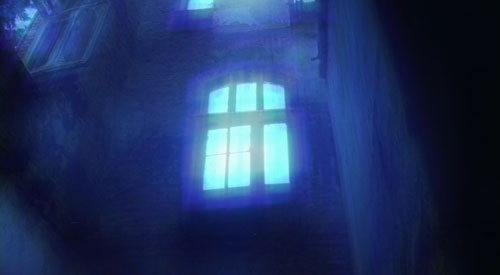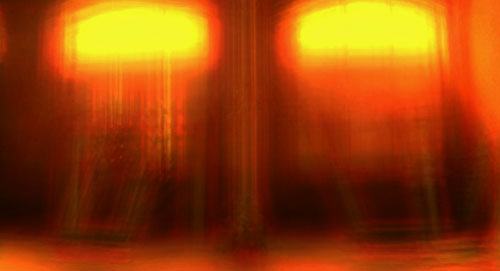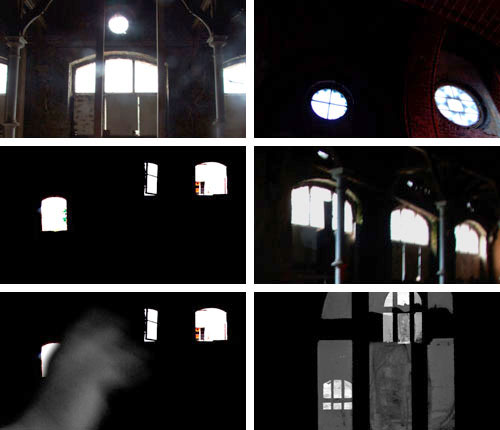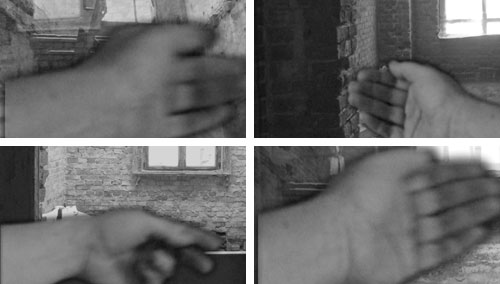


Windows. Bożenna Biskupska's laboratory of art
Chaos, Tunnel, Signs make up a work built of those three visual sequences, clearly linked by the motif of "a window". The "chasing thoughts away" of the title appears in the image of Chaos. Gestures, like pointing or flicking of the hand, play the function of a slate on a film set and mark the next takes, which in this case are similar. Chaos is the most expressive image here, unusually dynamic and changing very quickly: many different shapes of windows, set in some monumental architectural tissue, appear and disappear. The images of windows appear as if in the state of turmoil, permeation or invasion, they overlap, dissolve, approach, retreat, disappear and return. All of this happens at breakneck speed, in a flash, impulsively, creating the impression that the whole image will disintegrate and end with a final explosion which we anticipate. The artist somehow "chases" those chaotic thoughts/images away, only to see them reappear again in a moment. Thus we can ask a question: what is the meaning of this gesture? We usually chase away obsessive or tormenting thoughts. So what does the artist want to break free from? From what images, what art? Or on the contrary: what does she strive to do, what does she anticipate? Biskupska introduces the notion of chaos which is the symbol of the state the world had been in before any kind of being appeared in it, but which has been embracing it since then as a fixed source of power and restoration. It marks the disorderly, undifferentiated origin of things, and it is the phase which precedes the creation of the universe; according to Aristotle it is pure potential, and according to the stoics - it is the potential of the dynamic type. It comes before logos, i.e. the rule, proportion or intellect which gives order to human activity. Therefore chaos seems to possess a somewhat virtual character because although it is something that does not exist in the form of matter, materially, it offers the possibility for something to exist.
In Chaos the images of windows strongly tinted with symbolism multiply. The window - as the eye of a building - may open different perspectives on the world, determine our relations with what surrounds us and generally point to a subjective evaluation of reality. It shows that we are sensitive and open onto external reality, and in a metaphysical sense - onto the internal world. It may be the signal of opening onto ideas, as well as of illumination - because even though the window does not shine itself, it lets light in and out. In Bożenna Biskupska’s work the windows usually resemble pure, white light and rather do not reveal the landscape that lies beyond them. They are a sign of opening, of mainly internal cognition and of our approach to the changes that take place within us. They introduce an indeterminate state of discontinuation and create a contemplative atmosphere.
This reflective nature of the state of internal silence breaks the stream of sound or rather the multiplicity of voices imposed on the visual layer of the work. Our understanding of the texts read out loud is not important - but their presence is, because they belong to the universal text of culture as a whole to the same degree as they are elements of Biskupska’s artistic biography. They become a kind of play, as a hermeneutic philosopher (H.G. Gadamer) would say, between the understanding of the works by their intepreters and themselves. In a certain way they belong to chaos.
We should also note the common interest in different concepts of chaos and especially their use in the sphere of business and marketing in order to improve the current economic situation (Philip Kotler, Time of Chaos - Time of New Opportunities, conference, Warsaw 2009), not to mention Edward Lorenz’s theory of chaos from 1963, which claims that even the slightest disorders might cause revolutionary changes in different branches of science (like the so-called "butterfly effect" in meteorology).
The next stage of the work in question is Tunnel. The notion of tunnel is obviously related to a passage, though perhaps in this case it points to intuition or maybe to some other state of consciousness? The self-drawing line which is an abstract elongation of the vertical plank of the window-frame flows out of it in the direction of the viewer which suggests pointing him out or bonding with him. Verticality is a symbol of climbing and improvement, striving for perfection. Gradually the frame loses the significance of its real form. It becomes an abstraction, a sign. What can it mean, especially when we ought to remember that the artist is also the viewer of her/his own work?
The next stage of Bożenna Biskupska’s work is Signs. As Dorothea Forstner correctly observes: "Signs and figures are the highest symbols in which the spiritual world is directly reflected on earth, they are the most perfect creations of the human mind and it is thanks to them that we can get to know the visible universe in detail. Geometrical figures are the first «incarnations» of an immaterial number. Everything is contained in numbers and figures, so they are the foundation of everything, they revitalize and regulate everything. Philosophers and theologians of all time tried to visualize their deepest thoughts by means of geometry in many different ways". In Biskupska’s work real frames gradually give way to lines and figures, i.e. to their geometrical equivalents. The natural world undergoes transformation and turns into art. And art offers new possibilities of knowing and understanding the world. It offers its other dimension. Another dimension of human activity.
So is Chasing Thoughts Away, shown for the first time in 2009 at the FF Gallery in Łódź, an anticipation of the changes looming on the horizon, or perhaps rather a general assumption of uncontrolled chaos, marked by an ever-growing, disorderly excess of the often incoherent ideas of our times?
Jolanta Męderowicz


Copyright ©2009 Galeria FF ŁDK, Bożenna Biskupska, Jolanta Męderowicz